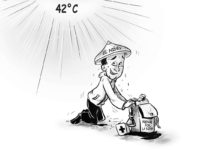
[av_one_full first min_height=” vertical_alignment=” space=” custom_margin=” margin=’0px’ padding=’0px’ border=” border_color=” radius=’0px’ background_color=” src=” background_position=’top left’ background_repeat=’no-repeat’ animation=”]
[av_heading heading=’Potentials of science tourism’ tag=’h3′ style=’blockquote modern-quote’ size=” subheading_active=’subheading_below’ subheading_size=’15’ padding=’10’ color=” custom_font=” av-medium-font-size-title=” av-small-font-size-title=” av-mini-font-size-title=” av-medium-font-size=” av-small-font-size=” av-mini-font-size=” admin_preview_bg=”]
BY JULIO P. YAP JR.
[/av_heading]
[av_textblock size=” font_color=” color=” av-medium-font-size=” av-small-font-size=” av-mini-font-size=” admin_preview_bg=”]
January 22, 2018
[/av_textblock]
[av_textblock size=” font_color=” color=” av-medium-font-size=” av-small-font-size=” av-mini-font-size=” admin_preview_bg=”]
A TOURISM branding project for students, budding scientists, or even armchair geniuses is currently in the works in Los Baños, Laguna.
Through the Los Baños Science Community Foundation, Inc. (LBSCFI), the project dubbed “Development of Science Tourism in Los Baños” was recently launched through the signing of a Memorandum of Agreement with the Cavite, Laguna, Batangas, Rizal, and Quezon(CALABARZON) branches of the Department of Tourism (DOT) and the Department of Education (DepED).
Due to CALABARZON’s history and natural resources, tourism plays a major role in the regional economy.
The project aims to promote science and technology (S&T), increase the number of tourists in Los Baños, and boost the engagements of local stakeholders and enterprises.
According to LBSCFI President and Department of Science and Technology (DOST) IV-A Regional Director Alexander R. Madrigal, the project also aims to “promote S&T as a career path among students.”
As an emerging niche tourism concept, “there is no body of knowledge yet in science tourism,” said Forester Roberto P. Cereno, chairperson of the LBSCFI Tourism Committee and director of the University of the Philippines Los Baños-College of Forestry and Natural Resources (UPLB-CFNR) Training Center for Tropical Resources and Ecosystems Sustainability.
However, Cereno emphasized the scopes of science tourism, which are “science in tourism” and “tourism in science.”
The former showcases S&T innovations and interventions, while the latter packages and promotes S&T ideas, discoveries, laboratory breakthroughs into “awe-inspiring” and “mind-blowing” tourist attractions.
For her part, DOT Region IV-A Regional Director Rebecca V. Labit expressed support to science tourism.
She describes the undertaking as “timely, needed, and speaks well of the sustainability for tourism.”
Also present during the launching were Los Baños Mayor Caesar P. Perez, Lopez Elementary School Principal Bernon Abellera, members of the national and local media, and representatives of the LBSCFI member-agencies.
Los Baños was designated as the “Special Science and Nature City” of the Philippines in 2000 based on Proclamation No. 349.
Visitors usually flock to this university town to witness the scientific outputs of LBSCFI member-agencies, which include the UPLB, International Rice Research Institute (IRRI), PCAARRD, DOST IV-A, and other institutions and organizations, aside from its natural wonders and other tourist attractions.
UPLB houses a botanical herbarium of more than 70,000 specimens; an entomological museum of more than 120,000 pinned insect specimens in 285 families and 22 orders and about 5,000 slide-mounted insect species as well as more than 75,000 slides of mites; a forestry herbarium and wood collection presents a collection of more than 12,000 specimens; a hortorium which nurtures around 400 species of food, medicinal, tonic and ornamental plants; a microbial culture collection of more than 400 strains of bacteria, 135 yeasts and 163 mold species and a number of algal cultures; a mycological herbarium boasting of a collection of more than 11,000 ascomycetes, basidiomycetes and myxomycetes; and a zoological and wildlife museum consisting of more than 15,000 stuffed birds and mammals, more than 500 reptiles, amphibians, mammals and birds in liquid preservation, and around 700 shells on display. (jaypeeyap@ymail.com/PN)
[/av_textblock]
[/av_one_full]



